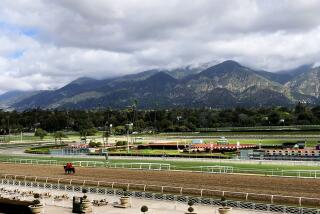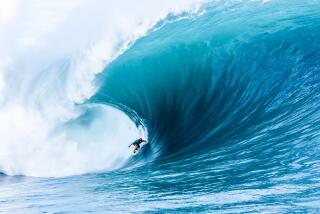Conner’s Fears of Early Elimination Prove to Be Unfounded
- Share via
The possibility that Dennis Conner’s Stars & Stripes might not even make the cut in the world 12-meter championships at Sardinia made a good story, except it wasn’t true.
It turned out that all eight boats advanced to the match-racing semifinals starting Saturday, according to the original plan of the host Yacht Club Costa Smeralda.
Conner himself was partly responsible for the confusion. Before leaving the country, the America’s Cup winner expressed fears to several reporters that if the winds were light, which they were, his boat would lose its Fremantle superiority and might not even be competitive, which, at times, it wasn’t.
“We’ll have to sail well to make the final four,” Conner said at the time.
And because he didn’t arrive in Sardinia until after the meeting on race instructions, Conner didn’t get the word officially.
The New York public relations firm hired by Costa Smeralda to funnel information to the American media also misunderstood until after the fleet races were completed and it learned nobody had been eliminated.
Beyond that, the six fleet races, four of which were sailed in light air and another partially so, raised some interesting points.
The former backup boats of the top two Australian America’s Cup syndicates emerged to lead the fleet: Kookaburra II, with Peter Gilmour at the helm, and Bengal (formerly Australia III), with Colin Beashel steering for its new Japanese owner, Masakazu Kobayashi.
Both were considered to be better light-air boats than their successors, Kookaburra III and Australia IV.
Although Beashel didn’t impress many people with his helmsmanship at Fremantle, indications are that the Japanese could be competitive immediately in their ’91 America’s Cup debut if Beashel or another experienced 12-meter skipper sails for them.
Finally, many sailors hate fluky wind, as at Sardinia, because luck often overtakes skill as the decisive factor. That theory might place pressure on the San Diego Yacht Club to re-examine whether its first priority should be to host the defense or to give Conner his best chance to defend the Cup.
Will the Sardinia experience strengthen the case for Hawaii as the site for the next America’s Cup?
During the 1951 Transpac race, the 73-foot cutter L’Apache was about halfway to Hawaii cruising at 10 knots when crewman Ted Sierks went forward to make a repair.
As he leaned against a life rail, the rail gave way and Sierks fell into the sea, disappearing almost immediately in the mountainous swells. By the time the huge boat could turn around, there was no sign of Sierks. Four other racing boats joined some Navy destroyer escorts in an overnight search, and they were about to give up when the commander ordered one last sweep at noon the next day.
At 1:30, two crewman spotted Sierks, who was pulled aboard 28 hours after the fall.
Tales such as that, along with records and facts, are included in Jack Smock’s book “Transpac, 1906-1979,” which has been updated with supplements for the three races since.
Romance, legend, adventure--it’s all there in the Transpac, which started in 1906 almost by accident. Clarence MacFarlane sailed his 46-foot schooner La Paloma from Hawaii to San Francisco, hoping to find somebody with whom to sail back, but instead found the ruins of the great earthquake.
So MacFarlane headed down the coast to San Pedro, where he persuaded two skippers to join him in the first race to Honolulu.
The 34th biennial Transpac started Thursday afternoon off the Palos Verdes peninsula with 55 competitors. The fleet tends to scatter quickly, not only because of wide differences in speed but the different courses taken.
The shortest line is not necessarily the fastest. The fastest way to Hawaii is aboard a 747. The next fastest is to find the strongest wind, ideally the mighty trades from the northeast that will sweep a boat along to the islands like a leaf on a pond.
Sometimes it’s north, sometimes it’s south, sometimes--as in ‘85--it’s nowhere to be found.
This week, John Henderson of the National Weather Service told skippers at a weather briefing about a stationary low pressure area lurking off the coast, and nobody knows when or where it will move.
The skippers will search for clues in the daily 10 a.m. radio roll calls when boats are required to give their positions by latitude and longitude.
Then they must decide whether to stay where they are or alter course. Merlin, for example, might conclude that Ragtime is doing better to the south and decide to join it.
The trouble is that in the next 24 hours, conditions can change.
Sailing Notes TRANSPAC CATAMARANS--Apparently, it isn’t a catamaran race without Randy Smyth. The 1984 Olympic silver medalist and sailmaker from Huntington Beach is steering Rudy Choy’s Aikane X-5 in what is billed as the “Open Transpac Record Run,” Los Angeles to Honolulu. That event started an hour after the Transpac monohulls Thursday and is virtually a match race between Aikane X-5 and Steve Shidler’s Wind Warrior from Newport Beach, skippered by Gino Morelli. Trimarans sailed by Michael Reppy of Redondo Beach and Mark Robson of Chula Vista are the only other multihulls entered. They’re trying for the record of 7 days, 7 hours, 30 minutes set by Bob Hanel’s Double Bullet in ’83. Smyth sailed on Wind Warrior in ’85 when it broke its mast step the first night out and retired. Smyth is stateside between races of the French-dominated European Formula 40 series, in which his chances of defending his ’86 championship now seem slim. Smyth missed the first race and broke a mast in the next two, but still plans to sail the last seven. Incidentally, France’s Philippe Poupon and crew last week set a record of seven days, five hours for the 3,400-mile transatlantic crossing. That computes to an average straight-line speed of 17.8 knots, so Poupon probably was hitting closer to 20. Considering that the Transpac is only 2,225 miles, Smyth said, “That means we should do it in about five days, but I don’t think we will.”
MATCH RACING--The King Edward VII Gold Cup, fifth of eight events in the World Match Racing Conference series, is scheduled next week at Bermuda. The field will lack some of the usual participants who are tied up in the 12-meter worlds at Sardinia, such as Peter Isler, Rod Davis, Peter Gilmour and Iain Murray. But John Shadden of Long Beach, who tied for second in the Congressional Cup this year, will compete. Davis, Gilmour, Murray and Eddie Owen have won the series’ first four events.
NOTEWORTHY--More than 70 boats from 27 to 65 feet are entered in the Metropolitan Yacht Club’s ninth annual Oakland-to-Catalina Island race scheduled to start Monday. The first are expected to reach Avalon on Friday. A “homeward bound” race from Avalon to Long Beach is scheduled Saturday, July 11, for the fleet and local racers. . . . Doug Jones, president of Performance Handicap Racing Fleet for Southern California, advises that “marine industry racers” (MIRs) may skipper/drive their own boats in events, as long as they meet the basic requirements for PHRF membership of owning a boat and belonging to a Southern California Yachting Assn. (SCYA) club. “But the limit of only one MIR on board still holds,” Jones said. . . . The second Pacific 1,000 catamaran marathon is scheduled July 21-Aug. 1, hitting beaches from San Diego to Santa Barbara. Defending champion Smyth will not compete because of his European Formula 40 conflict. . . . The United States Yacht Racing Union has published a Notice of Race or Regatta Guide as a format for race organizers. It’s available for $5 by writing Jan Craven at USYRU, Box 209, Newport, R.I. 02840. . . . Cruising World Magazine’s free national directory to sailing schools may be obtained by writing Cruising World Sailing Schools. 524 Thames St., Newport, R.I. 02840.
More to Read
Go beyond the scoreboard
Get the latest on L.A.'s teams in the daily Sports Report newsletter.
You may occasionally receive promotional content from the Los Angeles Times.






